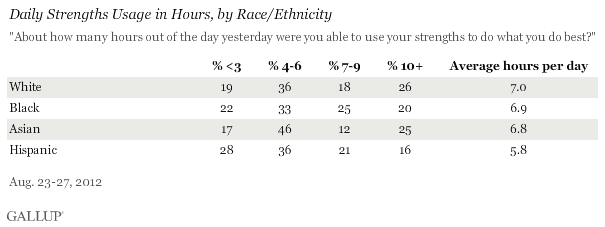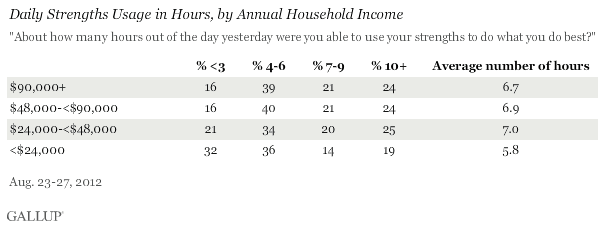WASHINGTON, D.C. -- The majority of American adults say they are not able to use their strengths to do what they do best throughout the day -- with 57% saying they use them for six hours or fewer each day. About one in four report that they use their strengths at least 10 hours a day. Women use their strengths for more of the day than men do, with 26% using their strengths at least 10 hours a day compared with 23% of men. Overall, women say they use their strengths an average of 7.1 hours each day versus 6.6 hours for men.

These findings are based on interviews with 5,049 American adults collected as part of Aug. 23-27, 2012, Gallup Daily tracking. Respondents were asked: "About how many hours out of the day yesterday were you able to use your strengths to do what you do best?"
Gallup defines strengths as activities for which one can consistently provide near-perfect performance. Individuals who report that they use their strengths to do what they do best have higher self-confidence, hope, altruism, well-being, and productivity. Gallup has spent more than a half-century studying human strengths, and more than 7.8 million people have taken Gallup's Clifton StrengthsFinder assessment -- which tests for 34 specific unique strengths -- since its inception in 1998.
Hispanics Least Likely to Use Strengths
Among racial and ethnic groups, whites report using their strengths an average of 7.0 hours per day -- compared with 6.9 hours for blacks and 6.8 for Asians. Hispanics are much less likely to say they use their strengths throughout the day -- averaging 5.8 hours a day. Twenty-eight percent of Hispanics report that they used their strengths to do what they do best for three hours or fewer "yesterday."

Less-Educated, Low-Income Least Likely to Use Strengths
Those who do not have a high school diploma are less likely than more educated Americans to report using their strengths during the day -- likely reflecting that the jobs available to them are less challenging, with little room for growth. Americans without high school diplomas say they use their strengths to do what they do best for an average of 6.1 hours per day, compared with averages between 6.8 and 7.1 hours for those with greater formal education. Twenty-nine percent of Americans with less than a high school diploma report using their strengths for three hours or fewer "yesterday." Those with formal education beyond high school are not significantly more likely to use their strengths than those with a high school diploma.

Similarly, low-income Americans are much less likely than those with higher incomes to say they use their strengths during the day. Those with incomes of less than $24,000 per year report using their strengths an average of 5.8 hours a day compared with averages of 6.7 to 7.0 for higher-income groups. Above moderate levels of income, Americans are no more likely to use their strengths.

Implications
In addition to higher self-confidence, hope, altruism, and well-being among American adults, Gallup's large-scale studies of workers suggest that those who report that they use their strengths on the job are more engaged in their work, exhibit higher performance, and are less likely to leave their organization. Business units whose employees receive feedback on their strengths are, on average, higher performing. And managers who receive feedback on their strengths have employees who are more engaged, profitable, and productive.
Use of strengths varies considerably by demographic and socio-economic subgroups, with higher-income and more highly educated Americans reporting using their strengths more often than their lower-income and less-educated counterparts. However, it appears that those with the highest incomes and most education are actually no more likely to use their strengths during the day than are those more in the middle range in terms of income and education. Income and education alone, therefore, provide no guarantee that people will spend a great deal of their day doing what they do best.
The majority of Americans do not maximize their strengths on a daily basis, suggesting a possible avenue for improvement in important life and work outcomes. This opportunity is even greater among those in the least-educated and lowest-income households. It is possible that these individuals will be better positioned for success upon learning, understanding, and using their strengths, relative to where they currently stand. It is also possible that those with higher incomes and education have achieved these outcomes in part because they better leveraged their strengths over time. Considering the value -- in terms of well-being and productivity -- that using one's strengths creates, if more Americans learn about their own strengths and put them to use, it could create a positive economic impact in the U.S. for businesses, communities, and individuals.
Survey Methods
Results are based on telephone interviews conducted as part of the Gallup Daily tracking survey Aug. 23-27, 2012, with a random sample of 5,049 adults, aged 18 and older, living in all 50 U.S. states and the District of Columbia, selected using random-digit-dial sampling.
For results based on the total sample of national adults, one can say with 95% confidence that the maximum margin of sampling error is ±1.2 percentage points.
The margin of sampling error for any given demographic group is larger, but is typically no greater than ±4 percentage points.
Interviews are conducted with respondents on landline telephones and cellular phones, with interviews conducted in Spanish for respondents who are primarily Spanish-speaking. Each sample includes a minimum quota of 400 cell phone respondents and 600 landline respondents per 1,000 national adults, with additional minimum quotas among landline respondents by region. Landline telephone numbers are chosen at random among listed telephone numbers. Cell phone numbers are selected using random-digit-dial methods. Landline respondents are chosen at random within each household on the basis of which member had the most recent birthday.
Samples are weighted by gender, age, race, Hispanic ethnicity, education, region, adults in the household, and phone status (cell phone only/landline only/both, cell phone mostly, and having an unlisted landline number). Demographic weighting targets are based on the March 2011 Current Population Survey figures for the aged 18 and older non-institutionalized population living in U.S. telephone households. All reported margins of sampling error include the computed design effects for weighting and sample design.
In addition to sampling error, question wording and practical difficulties in conducting surveys can introduce error or bias into the findings of public opinion polls.
For more details on Gallup's polling methodology, visit https://www.gallup.com/.
